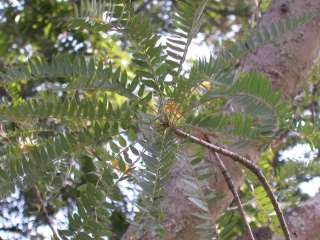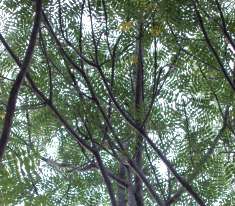Kirkia wilmsii
Kirkia wilmsii Engl.
Family: Kirkiaceae
Common names: mountain kirkia, wild pepper tree, mountain seringa (Eng.); bergsering, wildepeperboom (Afr.); Modumela (Northern Sotho)
SA Tree No: 269
Introduction
This medium to large tree has a spreading, irregular canopy that presents a spectacular sight when in full, bright red autumn colours. Any gardener with a medium to large garden will welcome this as a pleasing addition to their garden.

Description
Description

Deciduous, medium to large tree with a rounded crown and showing beautiful autumn colours from April to May. The trunk is known to branch near the base. Smooth grey bark, often showing irregular patching. The pale green leaves are crowned at the end of the branchlets and changes colour from reddish to bright scarlet in autumn. The flowers appear from spring to summer in sprays of greenish white to greenish cream. The fruit is pale brown and appears in summer; the fruit capsule splits open, revealing 4 valves.
Distribution and habitat
Distribution description
Kirkia wilmsii can be found on granite and dolomitic soils in dry bushveld, preferring rocky places. It is endemic to Mpumalanga and Limpopo. It can tolerate mild frost, but generally prefers a warm climate. It needs a moderate amount of water, but if necessary can survive short periods of drought as it stores water in its roots.
Derivation of name and historical aspects
History
This is a small genus with only two genera and five species in Africa. The members of this genus are known to prefer rocky areas. The genus name Kirkia was derived from kirkii referring to Dr (and later titled Sir) John Kirk (1832-1922). He was an English doctor and a plant collector. Apparently he accompanied Livingstone on his Zambezi expedition.
The species name wilmsii comes from F. Wilms (1848-1919) who was a German apothecary (pharmacist), botanist and plant collector, residing in Lydenburg. Another noteworthy Kirkia is Kirkia acuminata (white kirkia, white seringa) that has equally stunning, bright yellow to red autumn colours. It has a wider distribution, occurring in Limpopo.
Ecology
Ecology
This tree stores water in its roots, enabling it to survive short periods of drought. The flowers are thought to be pollinated by small insects and the seeds are mainly dispersed by the wind. Although browsers do not particularly like the leaves of this tree, elephants seem to be the exception, favouring the foliage.
Uses
Use
The leaves of this tree are used as goat fodder. The tree is a handy source of water to people in periods of drought - they get the water from the thickened roots of the tree, where it stores the water. The fibre obtained from the bark, young shoots and roots is rather strong and can be used for weaving.

Growing Kirkia wilmsii
Grow

This deciduous tree grows at medium tempo, preferring well-drained soils in a warm, sheltered place in cold areas. It grows best in full sun.
It is capable of withstanding mild frost and requires a moderate amount of water.
The tree is easily grown from seed and truncheons and is an excellent subject for large to medium-sized gardens, providing shade in summer, attracting butterflies in spring and providing exquisite autumn colours. It will do well as an accent point in your garden.
No significant pests have been documented on this tree.
References
- Grant, R. & Thomas, V. 2001. Sappi tree spotting: Lowveld including Kruger National Park, edn 2. Jacana, Johannesburg.
- Joffe, P. 1993. Die tuinier se gids tot Suid-Afrikaanse plante. Tafelberg, Cape Town.
- Leistner, O.A. (ed.). 2000. Seed plants of southern Africa: families and genera. Strelitzia 10. National Botanical Institute, Pretoria.
- Schmidt, E., Lötter, M. & McCleland, W. 2002. Trees and shrubs of Mpumalanga and Kruger National Park. Jacana, Johannesburg.
- Van Wyk, B. & Van Wyk, P. 1997. Field guide to trees of southern Africa. Struik, Cape Town.
Credits
Lou-Nita Le Roux
Lowveld National Botanical Garden
May 2004
Plant Attributes:
Plant Type: Tree
SA Distribution: Gauteng, Limpopo, Mpumalanga, North West
Soil type: Sandy
Flowering season: Spring, Early Summer
PH: Alkaline
Flower colour: Green, White, Cream
Aspect: Full Sun
Gardening skill: Easy
Special Features:
Horticultural zones







Rate this article
Article well written and informative
Rate this plant
Is this an interesting plant?
Login to add your Comment
Back to topNot registered yet? Click here to register.